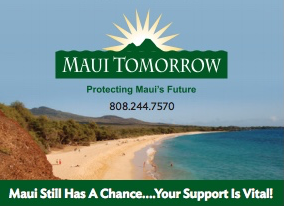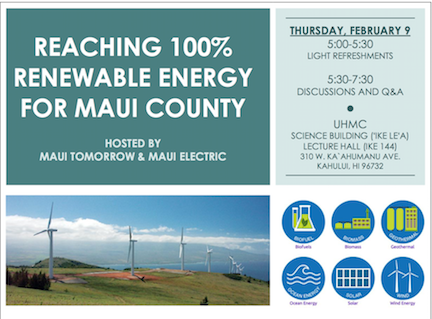Open the books on wind-energy plans
Editorial in the Star Advertiser July 13, 2011
Few issues brought before the state Public Utilities Commission have deserved as much scrutiny as the proposal to transmit energy from windmills on Lanai and Molokai to Oahu. The commission has made the right decision in allowing Maui County and the environmental group Life of the Land to become involved in the decision-making process.
The U.S. Department of Energy, Hawaiian Electric Co. and Hawaii state government have analyzed the Big Wind project for years, reaching a preliminary policy conclusion that supports an undersea cable carrying windmill-captured energy from the neighbor islands to Oahu homes. Alarmists have suggested that the move toward building such a network is little more than a secretive Politburo scheme without merit except to line the pockets of HECO.
In a move that provided more spotlight at this stage, Maui Mayor Alan Arakawa rightly complained he was not included in the information provided to the PUC regarding the project. Honolulu-based environmental group Life of the Land said it was offered copies of information only at steep, unaffordable prices.
The three-commissioner PUC agreed unanimously last week to allow Maui County and Life of the Land to intervene in the case, rejecting HECO’s argument that they be kept at arm’s length in various dockets. One of those includes a proposal that HECO charge ratepayers $3.9 million for studies examining transmission of wind-created energy into HECO’s Oahu grid.
In an eight-page decision, the commissioners found that the county and Life of the Land “have interests that are reasonably pertinent to the issues presented and that their participation can assist in the development of a sound record.” However, they warned that the county and environmental group may lose their “intervention status” if found to be “unreasonably broadening the pertinent issues raised … or unduly delaying the proceeding.” That’s a fair caveat, since the purpose of intervention should be to elevate the level of discussions, not mire them to the point of inaction.
The PUC, also commendably, ruled that Maui County and Life of the Land were right in saying that HECO must consider alternative forms of energy such as solar, biomass and biofuel when evaluating potential Big Wind costs.
Obviously, interest in a project estimated to cost more than $1 billion goes far beyond Maui and environmentalists and should be of importance to the general public. But be advised: The lay person will need diligence to absorb the technical aspects of the project as well as persistence to locate the information. In a letter to the editor last month, PUC Chairwoman Hermina Morita noted that anyone can view the commission’s website for information about the proposal — but the website is bureaucratically unfriendly; last week’s decision is difficult for typical online searchers to find without knowing the document’s number.
Still, the decision to allow access to Maui County and Life of the Land is a step forward for a commission accustomed to making quasi-judicial decisions behind bureaucratic doors. Given the enormous scope of Big Wind — its costs to HECO ratepayers as well as to neighbor islanders — this project needs to be vetted in the most transparent, accessible forum as possible. The public must pay attention — and, through Maui County and the environmental organization, now stands to benefit from a greater degree of openness than might otherwise have occurred prior to a final decision.


